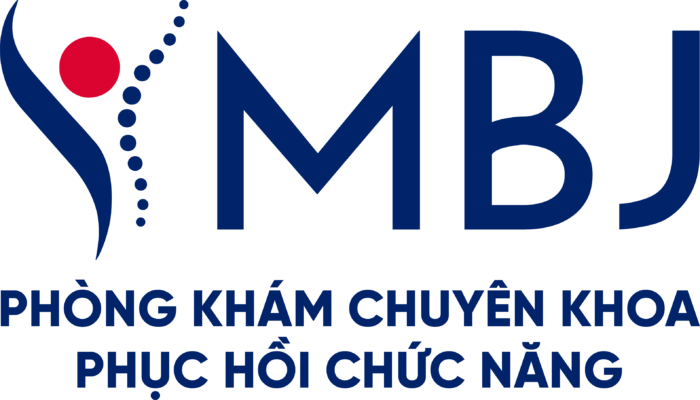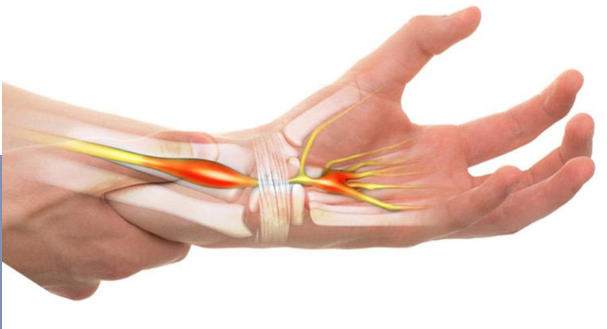Do you suddenly wake up at night with a feeling of numbness, aching, or tingling in your fingers? Do you find it difficult to grasp objects, or do you drop dishes, chopsticks, or your phone for no reason? This may not be a fleeting symptom but an early warning sign of carpal tunnel syndrome – a very common peripheral nerve compression disorder.
This condition is particularly common among office workers, assembly line workers, artisans, or anyone who performs repetitive wrist movements. This article, with consultation from medical experts, will provide a comprehensive overview of carpal tunnel syndrome, from its definition, causes, and warning signs to advanced treatment methods, especially the role of Physiotherapy and Rehabilitation in effectively treating the condition without invasive intervention.
Nội dung
- 1 I. What is Carpal Tunnel Syndrome?
- 2 II. Signs and Symptoms of Carpal Tunnel Syndrome
- 3 III. What Causes Carpal Tunnel Syndrome?
- 4 IV. Is Carpal Tunnel Syndrome Dangerous?
- 5 V. Current Diagnostic Methods for Carpal Tunnel Syndrome
- 6 VI. Treatment for Carpal Tunnel Syndrome: When is Surgery Necessary?
- 7 VII. Supportive Home Exercises for Carpal Tunnel Syndrome
- 8 VIII. Effective Prevention of Carpal Tunnel Syndrome
- 9 IX. Frequently Asked Questions (FAQ) about Carpal Tunnel Syndrome
- 10 Conclusion
I. What is Carpal Tunnel Syndrome?
Simply put, carpal tunnel syndrome is a condition where the median nerve is compressed as it passes through a narrow passageway in the wrist called the “carpal tunnel.”
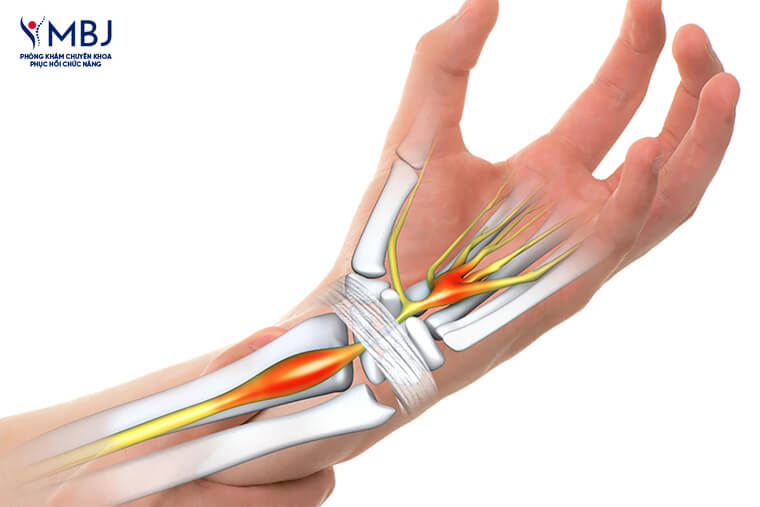
The carpal tunnel is formed by the carpal bones on the bottom and sides, and covered on top by a strong band of connective tissue called the transverse carpal ligament. Inside this narrow tunnel are not only the median nerve but also the flexor tendons of the fingers. When the space within the carpal tunnel narrows for any reason (such as swelling or inflammation), the median nerve becomes compressed.
The median nerve plays a crucial role, providing sensation to the thumb, index finger, middle finger, and half of the ring finger, while also controlling the movement of the muscles at the base of the thumb (thenar muscles). Therefore, when it is compressed, these functions are directly affected.
II. Signs and Symptoms of Carpal Tunnel Syndrome
The symptoms of carpal tunnel syndrome usually start gradually and worsen over time. Early recognition of the signs is crucial for timely treatment.
- Numbness, tingling, or a “pins and needles” sensation: This is the most typical symptom, usually appearing in the thumb, index, middle, and half of the ring finger. Patients often feel a “prickling” or as if their hand has “fallen asleep.” The little finger is not affected because it is controlled by a different nerve (the ulnar nerve).
- Pain or a burning sensation: The pain can radiate from the wrist up the forearm, sometimes reaching the shoulder.
- Symptoms worsen at night: Symptoms often become more severe at night and may wake the patient up. Many people have a habit of shaking or flicking their hands to relieve the discomfort.
- Weakness in the hand: The patient finds it difficult to grasp objects, perform fine motor tasks like buttoning a shirt or writing, or may easily drop things.
- Thenar muscle atrophy: In the late stages, when the nerve is severely damaged, the muscle mass at the base of the thumb may shrink and become flattened compared to the healthy hand.
Note: Hand numbness can also be a sign of cervical spine degeneration causing nerve root compression. However, nerve compression in the neck typically causes numbness that radiates down the arm in a different pattern and may be accompanied by neck and shoulder pain. A differential diagnosis must be performed by a specialist.
III. What Causes Carpal Tunnel Syndrome?
Any factor that increases pressure or reduces space within the carpal tunnel can cause the condition.
- Mechanical and Habitual Causes: This is the most common group of causes.
- Jobs that require repetitive wrist movements for long periods, such as office workers (using a mouse and keyboard), assembly line workers, hairdressers, musicians, and tailors.
- Improper wrist posture during work (excessive flexion or extension).
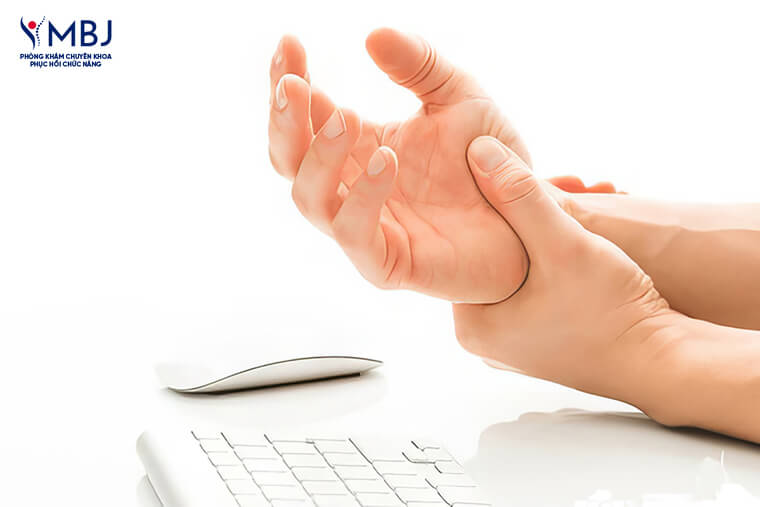
- Underlying Medical Conditions:
- Inflammatory joint diseases like rheumatoid arthritis and osteoarthritis of the wrist, which cause inflammation of the tendon sheaths.
- Diabetes, which increases the risk of nerve damage.
- Metabolic disorders such as hypothyroidism and acromegaly.
- Physiological Body Changes:
- Pregnancy or menopause: Hormonal changes can cause fluid retention, leading to edema and increased pressure in the carpal tunnel.
- Trauma:
- Wrist fractures, dislocations, or other injuries that alter the structure and compress the nerve.
IV. Is Carpal Tunnel Syndrome Dangerous?
Carpal tunnel syndrome is not a life-threatening condition. However, if not diagnosed and treated promptly, it can lead to serious complications that severely affect quality of life and work ability:
- Permanent nerve damage: Prolonged compression can cause irreversible damage to the median nerve.
- Loss of sensation in the fingers: The patient may completely lose feeling in the affected fingers.
- Muscle atrophy and loss of hand function: The hand becomes weak and clumsy, unable to perform daily tasks.
- Reduced or lost ability to work, affecting one’s economy and daily life.
V. Current Diagnostic Methods for Carpal Tunnel Syndrome
For an accurate diagnosis, a doctor will combine a clinical examination with necessary paraclinical tests.
- Clinical Examination: The doctor will ask detailed questions about symptoms, medical history, and job nature. Then, the doctor will perform several tests:
- Tinel’s Sign: Gently tapping over the area of the wrist where the median nerve passes. If you feel tingling or an electric shock in your fingers, the test is positive.
- Phalen’s Maneuver: You will be asked to flex both wrists fully and press the backs of your hands together. If symptoms appear within 60 seconds, the test is positive.
- Paraclinical Tests:
- Electromyography (EMG): This is the gold standard for diagnosis. This method measures the signal conduction speed of the median nerve and assesses the degree of nerve damage.
- Wrist Ultrasound: Helps visualize the structure of the carpal tunnel, detect tendon inflammation, and assess the degree of nerve compression.
- X-ray: Ordered to rule out other causes such as fractures or arthritis.
VI. Treatment for Carpal Tunnel Syndrome: When is Surgery Necessary?
The golden rule in treatment is to always prioritize conservative (non-surgical) treatment methods first. Surgery is only considered when these methods fail to provide relief or when there are signs of severe nerve damage.
6.1. Conservative Treatment
- Rest and Habit Modification: Limiting or changing activities that cause pressure and worsen symptoms.
- Using a Wrist Splint: Wearing a splint to keep the wrist in a neutral (straight) position, especially at night. This helps reduce pressure on the median nerve.
- Medication: The doctor may prescribe pain relievers, nonsteroidal anti-inflammatory drugs (NSAIDs), or local corticosteroid injections to quickly reduce swelling. Note: The use of medication must be under a doctor’s prescription.
6.2. Physiotherapy
This is a core treatment method that directly addresses the cause of the disease without medication or surgery. Understanding patients’ concerns about long-term medication use or facing the risks of surgery, MBJ Clinic is proud to offer a groundbreaking, safe, and effective treatment solution for carpal tunnel syndrome through Physiotherapy and Rehabilitation.
At MBJ, we do not apply a one-size-fits-all approach. Instead, we pioneer the development of 1:1 treatment protocols, combining the most advanced multi-technologies available today, “tailor-made” to the specific condition and severity of each patient. Our goal is to treat the root cause, release the compression, and fully restore the function of your hand.
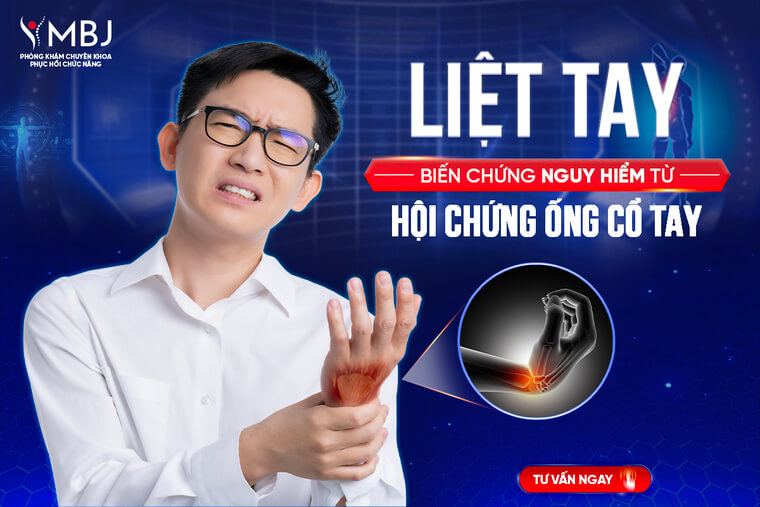
The comprehensive protocol at MBJ includes:
- Focused Shockwave Therapy: MBJ uses the latest generation of shockwave technology, capable of precisely targeting the point of pain and fibrotic tissues deep within the carpal tunnel. The energy from the waves breaks down calcifications and scar tissue compressing the nerve, helping to improve blood circulation and regenerate tissue. The superior pain relief can be felt immediately after the first session.
- High-Intensity Laser: The powerful energy from the laser penetrates deep into the damaged structure, performing biostimulation at a cellular level. This process accelerates the body’s natural healing process, restores damaged nerve fibers, provides strong anti-inflammatory effects, and eliminates pain at its root.
- Therapeutic Ultrasound: Multi-frequency ultrasound at MBJ helps reduce swelling and inflammation, and softens stiff tendons and muscles, thereby gently and effectively relieving pressure on the nerve.
- 1:1 Therapeutic Exercise with a Specialist: This is an essential step to ensure sustainable recovery. Each patient will be directly guided by MBJ’s team of experienced specialists through custom-designed nerve gliding, stretching, and strengthening exercises. This not only ensures correct technique and maximizes effectiveness but is also key to preventing future recurrence.
With MBJ’s treatment protocol, you can completely say goodbye to uncomfortable numbness and pain and regain flexibility in your hands without any invasive intervention.
6.3. Surgical Treatment
Surgery is indicated when:
- Conservative treatment fails after 3-6 months.
- There is evidence of severe nerve damage (muscle atrophy, loss of sensation).
The most common surgical method is to cut the transverse carpal ligament to expand the space of the carpal tunnel, thereby completely releasing the compression on the median nerve.
VII. Supportive Home Exercises for Carpal Tunnel Syndrome
These exercises can help alleviate symptoms; however, you must consult a doctor or physical therapist before practicing to ensure you perform them with the correct technique and that they are appropriate for your condition.
- Exercise 1: Nerve Gliding: Make a loose fist, then straighten your fingers and wrist, slowly moving your thumb away from the other fingers.
- Exercise 2: Wrist Flexor Stretch: Extend your arm straight in front of you with your palm facing up. Use your other hand to gently pull your fingers down until you feel a stretch in your forearm. Hold for 15-30 seconds.
- Exercise 3: Prayer Stretch: Press your palms together in front of your chest. Slowly lower your hands downward until you feel a gentle stretch in your forearms.
- Exercise 4: Rubber Ball Squeeze: Squeeze a soft rubber ball for 5 seconds, then release. Repeat several times to improve grip strength.
VIII. Effective Prevention of Carpal Tunnel Syndrome
“Prevention is better than cure.” Proactively protect your hands with these simple habits:
- Set up an ergonomic workspace: Ensure your monitor, keyboard, and mouse are at the proper height so your wrists remain in a natural, straight position.
- Use an ergonomic mouse and keyboard: These devices are designed to reduce pressure on the wrists.
- Take regular breaks: Every 30-60 minutes, stop, stretch, and perform stretching exercises for your wrists and hands.
- Keep your hands warm: Cold temperatures can increase pain and stiffness.
- Keep your wrists straight during work and sleep.
- Properly manage underlying medical conditions such as diabetes and arthritis.
IX. Frequently Asked Questions (FAQ) about Carpal Tunnel Syndrome
1. Can carpal tunnel syndrome go away on its own? In some mild cases, especially in pregnant women, the condition may improve on its own after childbirth. However, most cases require medical intervention to avoid complications.
2. What should I eat and avoid if I have carpal tunnel syndrome? You should increase your intake of foods rich in vitamins B6 and B12 (found in whole grains, bananas, fish) and anti-inflammatory foods (ginger, turmeric, green vegetables). Limit sugary foods, fatty foods, and stimulants.
3. How much does physiotherapy for carpal tunnel syndrome cost? The cost depends on the severity of the condition, the treatment protocol, and the number of sessions required. For accurate information, you should visit for a direct consultation with specialists.
4. How long does it take to see results from treatment? Many patients feel significant pain relief after just a few sessions with high-tech treatments like Shockwave Therapy and Laser. However, to fully recover and prevent recurrence, it is necessary to complete the full course of treatment prescribed by the doctor.
Conclusion
Carpal tunnel syndrome is a common condition that is completely treatable if detected early. Conservative treatment methods, especially Physiotherapy and Rehabilitation, are the optimal choice, helping thousands of patients escape pain and restore hand function without facing the risks of surgery.
Do not be complacent about numbness in your hands. Seeking an early diagnosis at a reputable medical facility is the key to protecting your health and quality of life.

 Tiếng Việt
Tiếng Việt